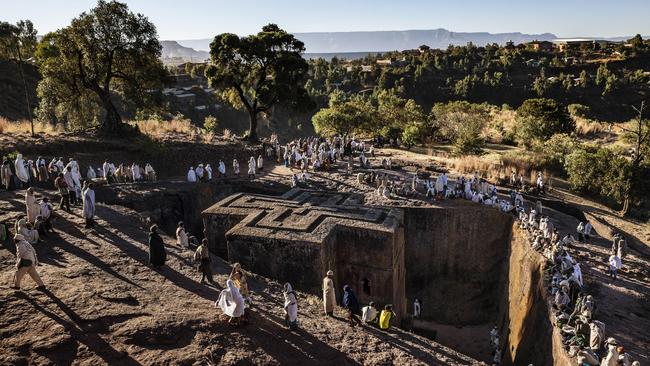Thousands of pilgrims preparing to visit ‘New Jerusalem’
THIS remarkable stone is impossible to see until you’re right on top of it. It’s called New Jerusalem, but it’s not where you’d think.

IT’S impossible to see until you’re standing right on top of it, and even then it takes a moment for the significance to register.
The roof is level with the ground, and carved to look like a Greek Orthodox Church. Pilgrims dressed in white gather around, close but not too close. The cross is in the middle of a man-made crater, and there’s a 12-metre drop to the bottom. The church of St George was carved from solid rock in the 12th century. It’s one of 11 churches near the village of Lalibela, nestled in the hills of northern Ethiopia. The churches are connected by a maze of tunnels, complete with hermit caves and catacombs. Some refer to it as “New Jerusalem”. When the original holy city was captured by Muslims in 1187, King Lalibela ordered a second one be built. His followers dug straight down into red volcanic scoria. The remarkable feat was completed in just 23 years, providing a safe place for Christians to pray as Muslims invaded Egypt and the north of Africa. The churches were named a UNESCO world heritage site in 1978. “These churches ... were hewn from the living rock of monolithic blocks. These blocks were further chiselled out, forming floors, windows, columns, various floors, roofs etc. This gigantic work was further completed with an extensive system of drainage ditches, trenches and ceremonial passages, some with openings to hermit caves and catacombs,” the United Nations World Heritage Committee wrote on its website. “I’m astonished that everybody doesn’t know about this place,” photographer Tariq Zaidi told CNN. “It’s a gem that is hidden at this point in time.” GALLERY The majestic site, however, has been rattled by earthquakes, and suffered severe water damage. Erosion is a constant threat, and while some temporary shelters have been erected to protect the structures, it compromises the site’s impact. “Other threats include encroachment on the environment of the churches by new public and private construction, housing associated with the traditional village adjacent to the property, and from the infrastructure of tourism.” As many as 20,000 people descend on Lalibela at the beginning of January each year to celebrate Genna, the Ethiopian Christmas. They often walk hundreds of kilometres in bare feet on the once-in-a-lifetime journey, sleeping in the open on plastic sheets. When they arrive in Lalibela, they sing, dance, pray and read their Bibles while the local community feeds them and washes their feet, lighting candles as the sun sets. “They’re very poor, very humble,” Mr Zaidi told reporter Thomas Page. “They come for the pilgrimage hopefully once in their life if they can afford it. Many people have walked across the country, with almost nothing with them. “They’re so happy — ecstatic — to be there and be part of this unique celebration.” However, tourism is trickling in. Last year, the European Council on Tourism and Trade named Ethiopia the “World’s Best Tourism Destination”. In addition to the Lalibela churches, there are eight other UNESCO sites, as well as the Erta Ale volcano. Tourists contributed $2 billion to the local economy in 2013, and numbers have risen 12 per cent over the past decade to reach 60,000 in 2014. The government hopes to increase that to $3 billion and one million visitors in coming years. The region is crippled with poverty. Lalibela is nearly 700km north of the capital, Addis Ababa, along a bumpy road. Electricity is sporadic, and all land belongs to the state. According toThe Economist, tariffs are sky-high, transport is irregular, and the government maintains a tight grip on industry and services. Regardless, the national economy is growing rapidly, up by 11 per cent in January 2016. Ethiopia lies in a troubled region. Last month, the government declared a six month State of Emergency following months of protests and unrest, causing death and injuries. Authorities have imposed random arrest and searches, outlawing of unauthorised demonstrations, curfews, and censorship on internet and communications technology. To the east, Somalia is plagued by terrorism, kidnappings and civil unrest. To the west, Sudan and South Sudan are both incredibly volatile in the wake of civil war. The Australian Government’s Smartraveller website advises Australians reconsider their need to travel to the country, and avoid the borders altogether. Tariq Zaidi told CNN the Genna ceremony was full of symbolism. At five in the morning, pilgrims dress in white and make their way through the tunnels. “There’s one particular passage in the network that is very long. I’ve got no idea how long it is -I’d guess 300 metres — and it’s pitch black,” he told Thomas Page. “There’s only one way in and one way out. There’s no turning back, and when you come out you come out literally at the door of the church. I was told that this corridor, like many others, was experiencing darkness going into the light — coming out into heaven, effectively.”




